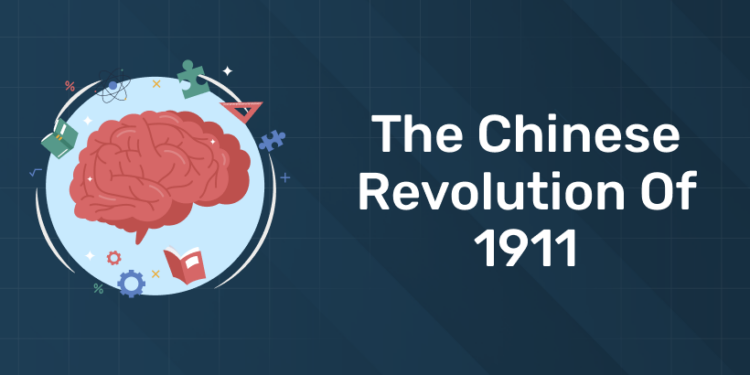Table of Contents
The Chinese Revolution of 1911 or the Xinhai Revolution is one of the important chapters in world history that marked a pivotal change in China, which overthrew the imperial rule and created a republic. In 1912, following the revolution, the three-century-long Quing (or Manchu) dynasty was demolished through a successful revolt, reshaping the political landscape of China. Political corruption, financial struggles, social unrest, and the influence of Western ideas were some of the factors that led to this revolution. In this blog post, we will delve into the underlying causes, far-reaching effects, and detailed timeline of the Chinese Revolution of 1911.
Causes of the Chinese Revolution
The Qing dynasty, which ruled China from the 17th century, began declining through the 19th century following corruption, internal strife, and foreign incursions into Chinese territory. Upon the death of the empress Dowager Cixi in 1908, the empire lost its last able leader. Back-to-back failures in wars (the Sino-Japanese wars and the Opium Wars) led to the imposition of unequal treaties by foreign powers, leading to widespread resentment among the Chinese population.
Rapid industrialization and urbanization further fuelled the unrest among the people, prompting the emergence of revolutionary groups seeking to build a unified China and bring down the Qing Dynasty. Both Japan and the West wanted more control over China. But the emperor Puyi, who came to power at the age of two after the death of the empress Cixi was incompetent to guide the nation.
The influence of Western concepts such as democracy, republicanism, and nationalism was also crucial in shaping the revolution. Educated and in touch with other countries, Chinese intellectuals and reformers began to advocate for a fresh political system to replace the dictatorial rule. Sun Yat-sen, one of the prominent figures in the Chinese revolution, was influenced by his education in the West and his exposure to modern political thought.
Revolution Begins
1: Who was the first woman President of India?
The chain of events leading up to the revolution began with the signing of an agreement with a four-strong group of foreign bankers on April 5, 1911, to construct tracks on the Hukwang Railway in central China.
The Beijing government decided to buy a line in Sichuan from a local company and use some of the money they borrowed to finish it. The amount the government offered did not meet the demands of the stockholders. An open result followed this dissatisfaction in September 2011.
A mutiny broke out among the troops in Wuchang after the uncovering of a plot in Hankou that had almost no connection with the Sichuan episode. This incident, known as the Wuchang Uprising, is regarded as the formal beginning of the revolution.
The revolutionaries captured the Wuchang mint and arsenal, intensifying and spreading the revolt like wildfire. Other provinces joined the revolutionaries and declared war against the Manchu government. As an immediate response, a set of demands intended to transform authoritarian imperial rule into a constitutional monarchy were met by the Qing court. The court urged Yuan Shikai, a former viceroy, to take charge as the new premier of China.
Yuan tried to recapture the areas from the revolutionaries, but by the end of the year, 14 provinces had declared against the Qing leadership. They joined the Revolutionary Alliance or Tongmenghui, an amalgam of groups that was formed by Sun Yat-sen in 1905.
Nanjing, the former capital of the Ming Dynasty, was taken over by the revolutionaries. Provincial representatives, in the inaugural national assembly at Nanjing, elected Sun as the provisional president of the newly declared Republic of China.
Free UPSKILLING Courses!
Take your first step toward mastering in-demand skills, acing interviews, and securing top-tier jobs with Entri's free upskilling courses.
Start Learning!Effects of the Revolution
Sun Yat-sen offered Yuan Shikai the president position if he could help form the Republic of China. On February 12, 1912, Puyi, the then-six-year-old boy emperor of the Qing Dynasty, was made to abdicate the throne. Yuan Shikai was given full powers to organize a provisional government after the proclamation transferred the government to the people’s representatives.
The authorities in Nanjing agreed that the emperor would keep his title and receive a substantial pension throughout his life. Sun Yat-sen resigned as president, and Yuan Shikai was chosen to take the position of president. In March 1912, the Nanjing legislature approved a provisional constitution, and in April, the government was transferred to Beijing.
The 1911 revolution was just a forerunner to the greatest Communist Revolution in China that was yet to happen in 1949. In the succeeding years, the government formed through the 1911 revolution failed to unify and properly govern the nation on the right path. The withdrawal of the Quin dynasty resulted in the emergence of a new group of warlords in certain regions. They kept their territories under their control without acknowledging the nationalist government, leading to newer problems.
Conclusion
The 1911 Revolution was a turning point in Chinese history. It marked the beginning of a new era by forming a republic, ending the three-hundred-year-old imperial rule. Political corruption, economic hardship, social unrest, and the influence of Western ideas were some of the factors that led to the revolution. Though the newly formed government succeeded in its early stages, including maintaining foreign diplomacy, it gradually failed in governing and unifying China. It also paved the way for the great Communist Revolution of 1949. The legacy of the revolution persists in shaping China’s political, social, and cultural landscape to this day.
Timeline of Chinese Revolution 1911
- 20 August 1905: Sun Yat-sen formed the Tongmenghui (United League), a revolutionary alliance aimed at overthrowing the Qing Dynasty.
- November 15, 1908: Empress Dowager Cixi dies and Puyi, the two-year-old successor becomes the monarch of the dynasty.
- October 10, 1911: Wuchang Uprising
- October-November 1911: Revolutionary forces gain control of multiple provinces, declaring independence from Qing rule.
- December 29, 1911: Delegates from various provinces gathered in Nanjing marking the formal establishment of the republic.
- January 1, 1912: Sun Yat-sen is elected as the provisional president of the Republic of China in Nanjing.
- February 12, 1912: The last Qing emperor, Puyi, formally abdicates the throne, ending over 2,000 years of imperial rule.
- March 10, 1912: Yuan Shikai officially becomes provisional president of the Republic of China.
Free UPSKILLING Courses!
Take your first step toward mastering in-demand skills, acing interviews, and securing top-tier jobs with Entri's free upskilling courses.
Start Learning!The Chinese Revolution of 1911 – Quiz PDF
Download Chinese Revolution – 1911 Quiz PDF for free!
The Chinese Revolution of 1911 – Quiz
1. Who ruled China during the 19th century leading up to the Chinese Revolution of 1911?
A) Ming dynasty
B) Han dynasty
C) Qing dynasty
D) Tang dynasty
2. What was the main goal of the Chinese Revolution of 1911?
A) To establish a communist government
B) To overthrow the Qing Dynasty
C) To expand Chinese territory
D) To end Japanese occupation
3. What was the immediate cause of the Chinese Revolution of 1911?
A) The Opium Wars
B) The Boxer Rebellion
C) The Wuchang Uprising
D) The May Fourth Movement
4. Who became the provisional president of the newly established Republic of China after the 1911 Revolution?
A) Sun Yat-sen
B) Li Yuanhong
C) Chiang Kai-shek
D) Yuan Shikai
5. The Chinese Revolution of 1911 is also known by which of the following names?
A) The Xinhai Revolution
B) The Taiping Rebellion
C) The Boxer Uprising
D) The Cultural Revolution
Answers
[1-C, 2-B, 3-C 4-D, 5-A]
|
Study Notes – World History |
|
| Magna Carta | |
| American war of Independence | |
| World War I | World War 2 |
Free UPSKILLING Courses!
Take your first step toward mastering in-demand skills, acing interviews, and securing top-tier jobs with Entri's free upskilling courses.
Start Learning!Frequently Asked Questions
What were the main causes that led to the Chinese Revolution of 1911?
The decline of the Qing dynasty due to corruption, internal strife, foreign incursions, rapid industrialization, urbanization, and the influence of Western ideas were some of the key factors that triggered the revolution.
What event marked the formal beginning of the Chinese Revolution?
The Wuchang Uprising in September 1911, where revolutionaries captured the Wuchang mint and arsenal, is considered the starting point of the revolution.
What were the immediate effects of the Chinese Revolution of 1911?
The abdication of the Qing emperor Puyi, the establishment of the Republic of China, and the appointment of Yuan Shikai as the president were some of the immediate outcomes of the revolution.












